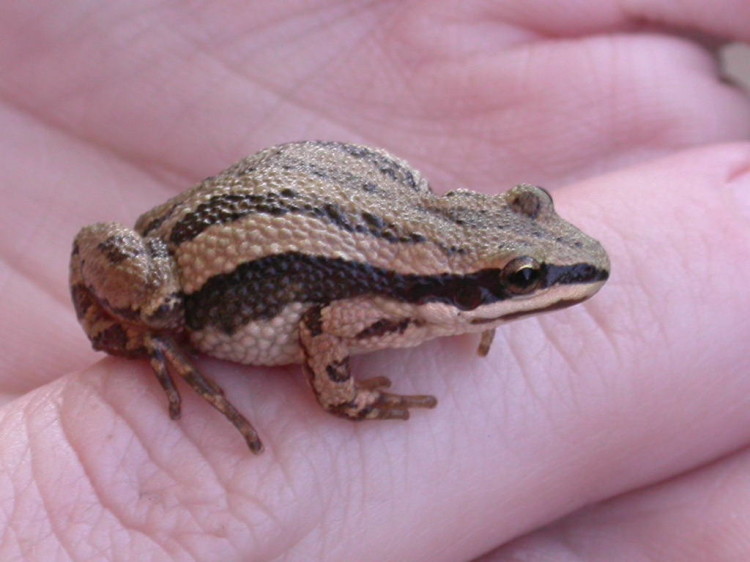
This tiny western chorus frog (note knuckle for size reference) is just one of many that are set to put on their annual spring concert.
The temperature’s rising, the days are getting longer, the buds are swelling, and the critters are emerging from hibernation. Spring is nearly here, and with it comes the annual performance of the chorus frog (Pseudoacris triseriata). But, despite the fact that chorus frogs are common statewide, there’s a good chance that you’ve never seen one.
In fact, many people go their whole lives without ever seeing a chorus frog (if you can call that living). At just over an inch in length, they are the smallest of Minnesota’s eleven species of native frogs. They are tan or light green in color with 3 dark brown stripes running down the back and an additional stripe running along each side, from the eye back to the legs. Their small size and exceptional camouflage allows them to blend in extremely well with almost any kind of vegetation, rendering them virtually undetectable.
Undetectable, that is, until they open their mouths. The most conspicuous thing about these little frogs is their song. In fact, it is likely that nearly everyone has heard the song of the chorus frog. It is a special song with special significance. As winter’s chill gives way to spring’s thaw, the chorus frogs are the first to become vocal on our ponds, lakes, wetlands and rivers. Many even begin calling before all the ice is off the water. For this reason, the sound of the chorus frog is truly one of the first signs that spring is near.
The repetitive, rasping calls are done only by the males. Upon the arrival of the first warm nights of early spring, male chorus frogs sit upright amid clumps of vegetation at the shallow water’s edge. The high-pitched prrreep, prrreep sound produced by each male is very loud for such a small frog. The females of the species, by contrast, are almost entirely silent.
The song of a male chorus frog is very similar to the sound of a fingernail on a comb, only much louder. It can be reasonably duplicated by dragging a fingernail across the shortest 20 or so teeth of a good stiff pocket comb.
The call of a lone chorus frog is quite loud by itself, but as the weather warms, more males join in, and the volume and pitch of the calls intensify. As they begin to congregate, the male frogs naturally space themselves out along the water’s edge, each one claiming its own small piece of real estate from which to state his intentions (which, I assure you, are entirely dishonorable).
Upon emerging from hibernation, females hear the serenade and are attracted to it. If a female is attracted to a particular male’s call, she will swim toward him. With so many frogs in the pond, there is little time for a serious relationship, or even proper introductions. Often, the male is so anxious to mate that he will jump into the water even before the female reaches him. Many males simply claim the first female that might be swimming in their general direction resulting, one can only assume, in the occasional awkward romantic misunderstanding.
Upon reaching each other (cue the swelling romantic music) the male will cling to the female in a passionate embrace. At this point, the female will release her eggs, and the male fertilizes them as they are released from the female’s body. The eggs are bound within a gelatinous substance which is then attached to a nearby clump of vegetation.
The eggs are left to develop and hatch without any further assistance from the parents. The adults usually part company shortly thereafter and spend the rest of the spring and summer searching for food to recharge their depleted bodies and prepare for next year’s hibernation.
Although egg predation is high, the surviving eggs hatch in only a few days, and the tadpoles grow quickly feeding mostly on algae. By July, the young will have sprouted legs and lost their gills to become terrestrial adults. At this point, the new adults will generally be free to go where they please. Actually a kind of tree frog, chorus frogs can adapt and survive in a wide variety of terrestrial habitats, including gardens, backyards, parks, and road ditches.
So keep your eyes open this summer and you might get a chance to see a chorus frog. Keep your ears open this spring, and you’ll definitely get a chance to hear them.
Scott Moeller is Naturalist and Director at Linnaeus Arboretum